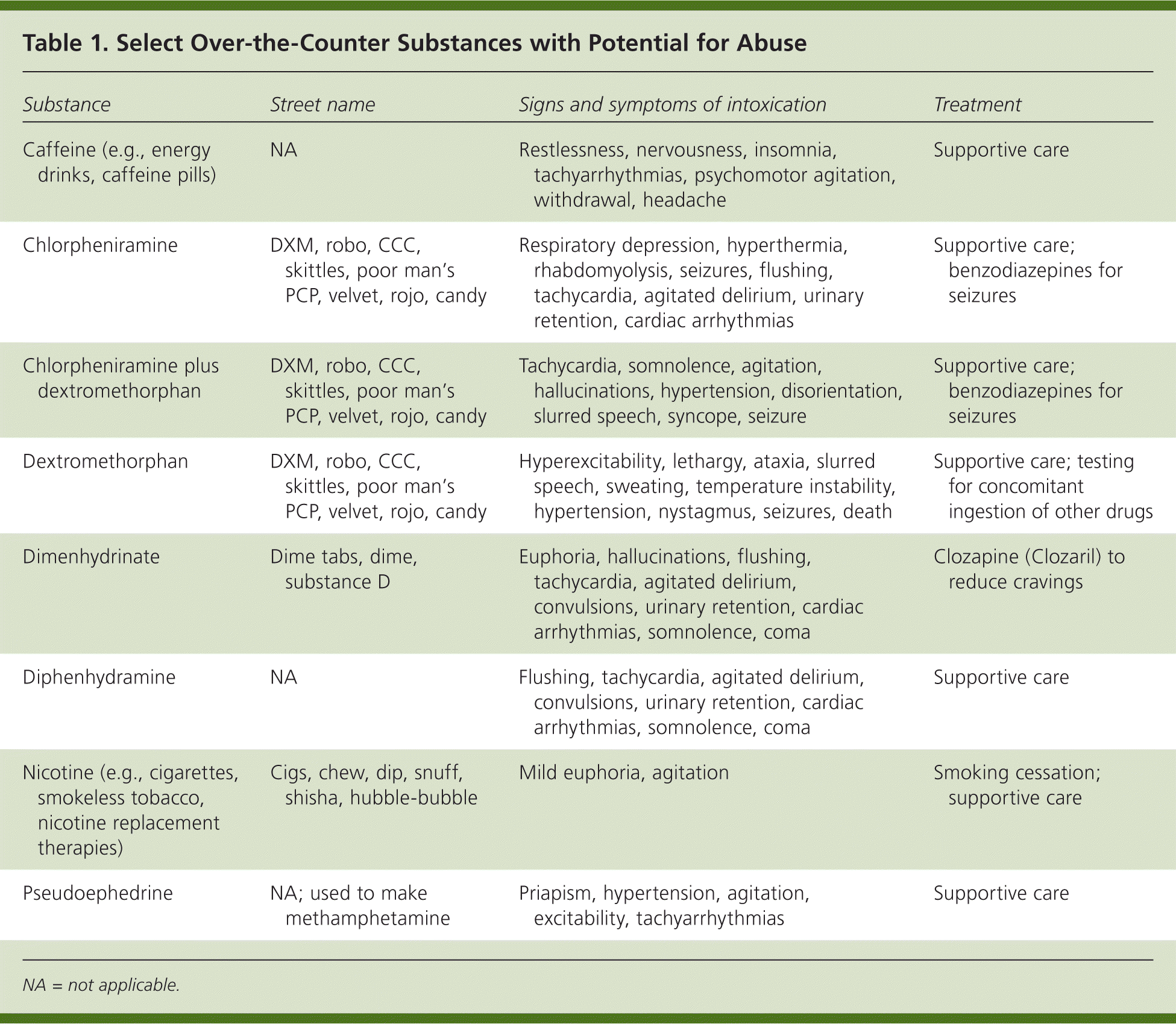
Am Fam Physician. 2011;84(7):745-750
Author disclosure: No relevant financial affiliations to disclose.
In recent years, recognition of over-the-counter (OTC) medication abuse by patients—especially teenagers and young adults—has increased.1 Abuse is defined as the use of a drug to experience psychoactive effects instead of for its medical indication. OTC medications are easily abused because they are inexpensive, legal, and widely available (in supermarkets and pharmacies, and via the Internet), and because they have no age requirement or limit on the amount purchased. Many patients think that OTC medications are safer than prescription or illicit drugs.2 Abusers of prescription drugs or illicit substances may also abuse OTC medications, or substitute an OTC drug when other substances are unavailable.3
The wide variety and accessibility of OTC drugs and lack of surveillance mechanisms make it difficult to gather national data; thus, neither the National Survey on Drug Use and Health nor the Monitoring the Future survey has examined the full scope of OTC drug abuse. Nevertheless, the medical literature supports this as an emerging issue. About 3.1 million persons between 12 and 25 years of age (5.3 percent) reported using OTC cough and cold medications to get high in 2006, according to the Substance Abuse and Mental Health Services Administration.4 A Utah survey showed that 38 percent of illicit drug use among teenagers and children from 1990 to 1999 involved OTC drugs.5 Admission to drug treatment centers for OTC medication abuse increased by more than 30 percent between 1993 and 2003.5 Cases of dextromethorphan abuse that were reported to poison control centers increased sevenfold from 1999 to 2004; most of these reports involved 15-and 16-year-olds.6 Studies suggest that adolescents and young adults are at greatest risk of OTC drug abuse. Table 1 lists select OTC medications with potential for abuse; dextromethorphan is of particular concern.6

| Substance | Street name | Signs and symptoms of intoxication | Treatment |
|---|---|---|---|
| Caffeine (e.g., energy drinks, caffeine pills) | NA | Restlessness, nervousness, insomnia, tachyarrhythmias, psychomotor agitation, withdrawal, headache | Supportive care |
| Chlorpheniramine | DXM, robo, CCC, skittles, poor man's PCP, velvet, rojo, candy | Respiratory depression, hyperthermia, rhabdomyolysis, seizures, flushing, tachycardia, agitated delirium, urinary retention, cardiac arrhythmias | Supportive care; benzodiazepines for seizures |
| Chlorpheniramine plus dextromethorphan | DXM, robo, CCC, skittles, poor man's PCP, velvet, rojo, candy | Tachycardia, somnolence, agitation, hallucinations, hypertension, disorientation, slurred speech, syncope, seizure | Supportive care; benzodiazepines for seizures |
| Dextromethorphan | DXM, robo, CCC, skittles, poor man's PCP, velvet, rojo, candy | Hyperexcitability, lethargy, ataxia, slurred speech, sweating, temperature instability, hypertension, nystagmus, seizures, death | Supportive care; testing for concomitant ingestion of other drugs |
| Dimenhydrinate | Dime tabs, dime, substance D | Euphoria, hallucinations, flushing, tachycardia, agitated delirium, convulsions, urinary retention, cardiac arrhythmias, somnolence, coma | Clozapine (Clozaril) to reduce cravings |
| Diphenhydramine | NA | Flushing, tachycardia, agitated delirium, convulsions, urinary retention, cardiac arrhythmias, somnolence, coma | Supportive care |
| Nicotine (e.g., cigarettes, smokeless tobacco, nicotine replacement therapies) | Cigs, chew, dip, snuff, shisha, hubble-bubble | Mild euphoria, agitation | Smoking cessation; supportive care |
| Pseudoephedrine | NA; used to make methamphetamine | Priapism, hypertension, agitation, excitability, tachyarrhythmias | Supportive care |
When treating a patient for a drug overdose, it is important to screen for multiple drugs, because many OTC cough and cold medications contain more than one active ingredient. Furthermore, overdoses can occur with a combination of OTC, prescription, and illicit drugs, as well as alcohol and other substances. In such instances, toxicity may be additive. Reporting overdoses to poison control centers is crucial so that data can be collected to support policy changes, such as placing an OTC drug behind the pharmacy counter or taking it off the market.
About 70 percent of parents report discussing the risks of marijuana use with their children, but only 36 percent say they have discussed prescription drug use, and only 33 percent have discussed OTC cough or cold medication use.2 Family physicians have an important role in identifying and preventing OTC drug abuse. When appropriate, physicians should inquire about all drug use, including prescription, OTC, herbal, and illicit substances; treat pain appropriately so patients do not self-medicate; refer patients to 12-step programs or detoxification programs when a problem is detected; and educate patients and their families about OTC drug abuse.7
